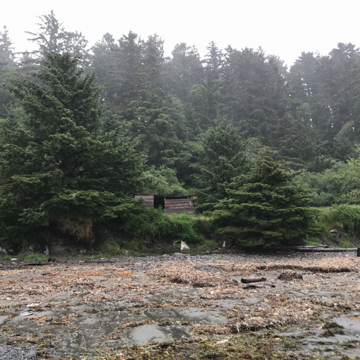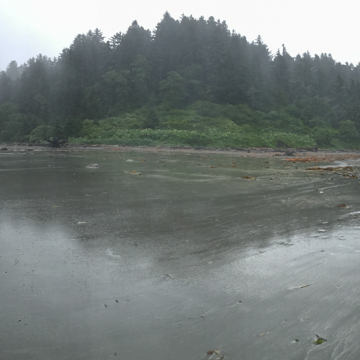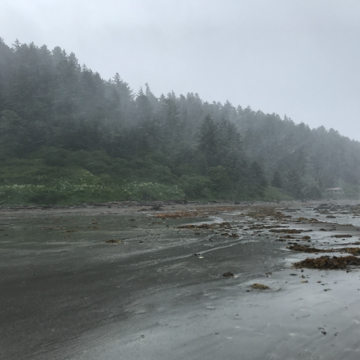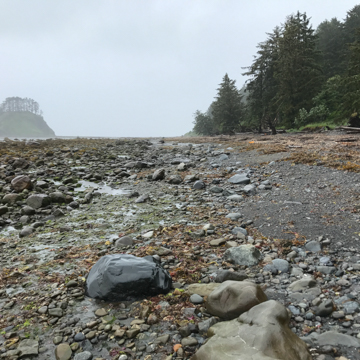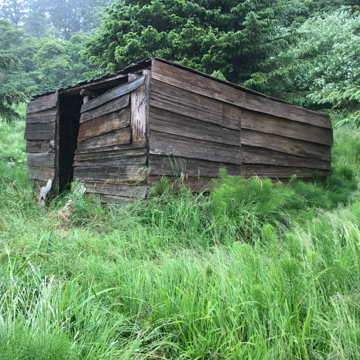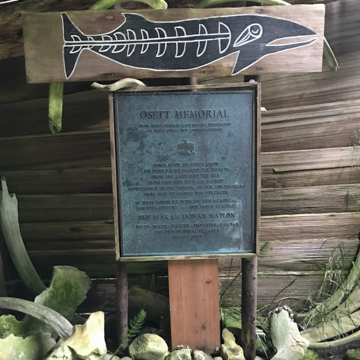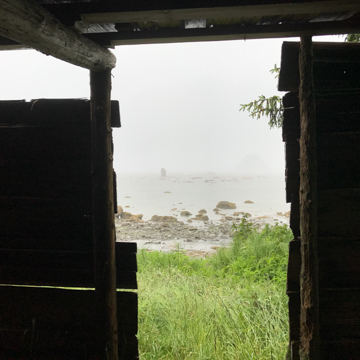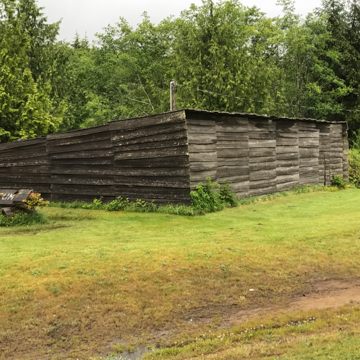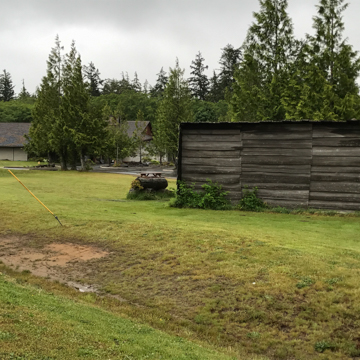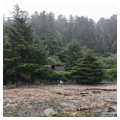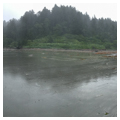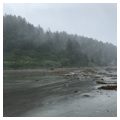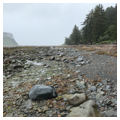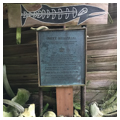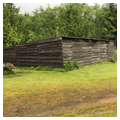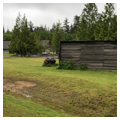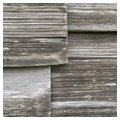You are here
Ozette Archaeological Site
Oral history of the Makah peoples had long told of a cataclysmic event, centuries ago, that buried part of a beachside village known as Ozette. Despite written documentation about a settlement on the edge of the Olympic Peninsula in Washington’s most northwesterly corner, to western archaeologists and historians, that event remained shrouded in myth until excavations began in earnest in the mid-1960s. The stories of an extraordinary, centuries-old native village tucked into the base of a steep hillside and disappearing into the thick cedar forest rising behind it seemed as misty as the coastal fogs that regularly blanket the northwest coast.
Still, evidence of human occupation existed at this location in the written record at least since 1834, when three wrecked Japanese seafarers made note of 16 houses at Ozette in their travelogue; five years later, the Pacific Coast Pilot reported a fishing, whaling, and seal-hunting village with as many as 20 houses. Yet by the 1920s, when the U.S. federal government was requiring all children to attend school, there was none at Ozette. Families began moving about 16 miles north to the Makah village at Neah Bay, where the nearest school was located. Ozette was abandoned, its built environment gradually returning to the natural environment.
The Ozette site remained known to archaeologists. In 1947, Richard Daugherty—then a graduate student at the University of Washington—hiked the coastal Olympic Peninsula and recorded 50 possible archaeological sites, of which Ozette suggested the most promise. Beyond shells and charcoal from centuries-old hearths, at Ozette Daugherty discovered cedar planks, basketry, and whale bone extending from a seabank along the beach. He did nothing more with the site until the summer of 1966, when, as a professor of archaeology at Washington State University (WSU) and with the approval of the Makah Tribal Council, he brought WSU students to study Ozette with the help of a National Science Foundation grant.
The archaeological team began by digging a nearly 230-foot-long trench from the beach, extending upwards to the outer edge of the forest. Another excavation followed the next summer at a site a little further south. These two excavations uncovered several artifacts that revealed a European-American presence (including metals, glass, and parts of rusted rifles), while Japanese coins suggested the site’s connection with the Far East—although it was difficult to decipher whether those coins resulted from human contact or drifted ashore after an epic journey across the Pacific Ocean. A midden, featuring artifacts and discarded shells, was also discovered; the items disclosed an indigenous historical trajectory reaching back some 1,600 years. Under Daugherty’s direction, Ozette’s long and complex record of human settlement began to unfold.
Yet it was a February 1970 storm that tore apart the hillside and exposed an array of additional artifacts, confirming Ozette as of one of the longest continuously occupied settlements in North America. A major excavation, lasting until 1981, unveiled boxes, bowls, baskets, combs, looms, canoe paddles, woodworking tools (such as adzes, wedges, mauls, and chisels), arrow flints, whetstones, fishnets, clubs, harpoon shafts, and seal and whale bones for a coastal community that presumably relied upon the sea for its subsistence. Remnants of imagery common to indigenous cultures of the coastal Pacific Northwest, including thunderbirds, whales, and wolves, were found inscribed on some of the walls and artifacts. This suggested that the people of Ozette shared belief systems, as well as artistic traditions, with coastal regional brethren such as the Tlingit, Haida, or Kwakwaka’wakw.
The storm also exposed wooden beams, rafters, posts, columns, planks, and walls that together intimated the presence of several once-substantial houses where many of the artifacts were found. The proximity of the artifacts to one another, several structural elements all lying in a particular direction, and their excellent preservation within a 10-foot-thick layer of mud helped tell of the everyday life of the Makah at a particular moment in time. What was likely a devastating mudslide, believed either to have occurred in 1560 CE or in 1700 CE (following the massive Cascadia earthquake and tsunami), has been an extraordinary boon to preservation, protecting from decay more than 50,000 normally perishable wooden items. Due to the suddenness of the natural disaster and the subsequent preservation of thousands of artifacts, some demonstrating a continuous run of occupation dating back to 200 BCE, Ozette earned the moniker “The American Pompeii.”
In order to proceed with the excavation, however, Daugherty had to again receive the blessing of the Makah Tribal Council, and then solicit assistance from Makah locals and scores of WSU graduate students to undertake what would become a massive 11-year project. Painstaking excavation, much of it accomplished with high-pressure water, helped remove hardened clay particles and brought tens of thousands of buried artifacts to light. U.S. Marine and Coast Guard helicopters provided regular transport of these artifacts to a laboratory in Neah Bay, which is not connected to the archaeological site by road and is too difficult to travel safely by water. By 1979, the Fred Bassetti and Company–designed Makah Cultural and Research Center had opened in Neah Bay as a permanent repository for the display, interpretation, and restoration of Ozette material culture.
Although roofs and most walls were crushed by the mudflow, enough planks and foundations remained for archaeologists to determine that as many as 8 post-and-beam houses (including one believed to be nearly 800 years old), holding as many as 40 people at one time, once populated the beach at Ozette. These houses featured structural elements and walls of western red cedar—the same type of wood used by indigenous peoples throughout the coastal Pacific Northwest because of its abundance, durability, and pliability. At Ozette, the versatile red cedar trees were discovered in the round for corner posts, split and extracted for roof and wall planks, and employed for their bark and branches—from which ropes and ties could be manufactured to help bind planks together and hold walls in place. The Makah used other local materials for construction purposes as well: even massive whale bones were linked together to serve as retaining walls and placed on floors to cover drainage ditches.
The houses at Ozette are believed to have averaged approximately 2,500 square feet—their long sides extending to 65 feet and their width to 40 feet. Heights varied because roofs typically sloped from west to east to facilitate water runoff, but most houses were believed to have at least 10-foot-high ceilings with holes for smoke release. Columns or posts were notched to support rafters; the rafters, in turn, supported the roofs. For waterproofing, the edges of roof planks were carefully indented along their long edges to allow for other interlocking planks. Rocks were used to line postholes and secure the principal structural columns; they also helped hold down the roofs. With the framework in place, it is believed that Makah builders installed planks between those posts to form the house perimeter, overlapping those planks to further seal the building from the elements. Occasionally, builders inserted canoe paddles or whale scapula into walls to fill holes or prevent collapse. Tall wooden poles, which may have been placed outside as fish-drying racks, also were discovered.
The many artifacts uncovered at Ozette, some inscribed with imagery, suggest interior spaces filled with both functional and decorative objects. Built-in furniture, such as the benches along the house perimeter, may have been used equally for sleeping, meal preparation, eating, and tool chiseling. No floor planks were revealed during excavation, however, and the houses lacked windows and would have been mostly dark—save for whatever light penetrated the single front door and the fires from burning hearths. Some of the houses were thought to be cleaner and better swept than others, suggesting the presence of enslaved persons and a social hierarchy that was also common to other small-scale Pacific Northwest societies.
While much of the original architecture was removed from the site and brought to the Makah Cultural and Research Center for preservation and/or restoration, no attempt was made to reconstruct an ancient Ozette Makah dwelling from existing foundations, columns, and walls. However, a full-scale interpretation of an Ozette Makah dwelling—as one may have appeared prior to the mudflow—was designed and built by Lance Wilke, a native Makah, outside the cultural center in Neah Bay in the early 1980s, easily visible to passing motorists along Bayview Avenue. Wilke also used red cedar and attempted to replicate ancient Makah construction practices, including lipped roof planks and overlapping wallboards tied in place with withes. This house is the best full-scale approximation of an ancient Makah longhouse, although others, serving a variety of educational and cultural purposes, have been built elsewhere in Washington in the late twentieth and early twenty-first centuries: at The Evergreen State College in Olympia (1995), Peninsula College in Port Angeles (2007), and the University of Washington in Seattle (2015).
Perhaps a fully intact house will be discovered in the future. Daugherty’s archaeological philosophy always was to leave 90 percent of any site untouched to permit future discovery, technologies, and interpretation, and with limited funding available for “wet-site” projects, Ozette has been largely left alone since the last shipment of artifacts was flown to Neah Bay in the early 1980s. To protect the archaeological site in the meantime, it has been filled and permitted to re-vegetate, and it is off-limits to visitors. Yet the spectacular remote setting, with dramatic sea stacks rising from offshore islands, can be reached on foot along the beach following the 3-mile northwesterly Cape Alava trail through a rainforest in Olympic National Park. The general location of the site, today part of the Ozette Indian Reservation, can be approximated by locating a small-scale re-creation of a Makah longhouse, also completed by Lance Wilke, along the beach shelf just north of a deteriorating ranger station.
References
Ames, Kenneth. “The Place of Ozette in Northwest Coast Archaeology.” In Ozette Archaeological Project Research Reports 3, Ethnobotany and Wood Technology, 9-25. Edited by David Welchel. Washington State University Reports of Research 68, National Park Service, Northwest Regional Office, Seattle, 2005.
Croes, Dale. Email to author, April 26, 2017.
Kirk, Ruth. Ozette: Excavating a Makah Whaling Village. Seattle: University of Washington Press, 2015.
Kirk, Ruth. Email to author, October 14, 2017
Steury, Tim. “A Dialogue with the Past: Modern Archaeology in the Pacific Northwest and What We Are.” Washington State Magazine (Summer 2008).
Writing Credits
If SAH Archipedia has been useful to you, please consider supporting it.
SAH Archipedia tells the story of the United States through its buildings, landscapes, and cities. This freely available resource empowers the public with authoritative knowledge that deepens their understanding and appreciation of the built environment. But the Society of Architectural Historians, which created SAH Archipedia with University of Virginia Press, needs your support to maintain the high-caliber research, writing, photography, cartography, editing, design, and programming that make SAH Archipedia a trusted online resource available to all who value the history of place, heritage tourism, and learning.












